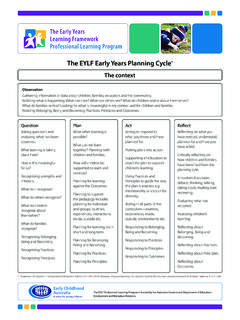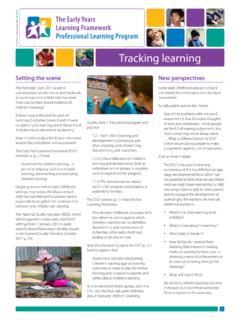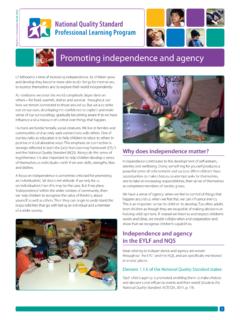Transcription of Community engagement - Early Childhood Australia
1 1 NQS PLP e-Newsletter 2012 Community engagementA Community is more than just a location, or a collection of individuals who happen to live or work in the same place. When we talk about a sense of Community we usually mean the quality of the relationships and connections that bind people together, rather than just the fact that they see each other regularly. As Early Childhood educators, creating a sense of Community is an important part of what we do. It is integral to the core themes of belonging and identity that run through the Early Years Learning Framework (EYLF): Children learn about themselves and construct their own identity within the context of their families and communities (DEEWR, 2009, p.)
2 20). While the saying it takes a village to raise a child may have become a clich , the idea behind it that children grow up as a part of a Community remains an important one. Children do grow up in the context of a Community . How we acknowledge this and engage with our own local communities will have a significant impact on children and families, as well as on our own ways of working. For children, a sense of Community plays an important role in the development of their feelings of belonging and security. Children thrive in an environment of mutually supportive and caring relationships. For this reason developing a sense of Community within a service is crucial. It is also valuable for children to feel part of a wider Community that extends beyond the learning environment.
3 As children grow and develop, connections to the outside world help them to find their place in the world, to develop understandings of how society works, and to recognise and understand the shared values that underpin our society. For many families Early Childhood settings often provide their first contact with a wider Community beyond the home. Because of this, Early Childhood services can act as an important point of connection for families. They can foster supportive relationships between families as well as connecting families to other organisations and services in the local Community . Strong links with the local Community also provide educators with invaluable information and resources.
4 By drawing on Community knowledge and expertise, educators are better able to understand the children and families with whom they work, and better able to provide children with learning experiences that are meaningful and relevant to their lives. For all of these reasons the EYLF and the National Quality Standard (NQS) both emphasise the importance of Community engagement : Learning Outcome 2 of the EYLF focuses on children s connectedness with others and with the wider world (DEEWR, 2009, p. 25) Standard of the NQS requires services to develop links with relevant Community and support agencies (NQS Element ) and, more generally, to build relationships and engage with the local Community (NQS Element ) (ACECQA, 2011, p.)
5 159). Finding ways to effectively engage with the Community , and the time in which to do it can be challenging. Our tendency to imagine that whatever we do in relation to the Community has to be big is not helpful either small is fine!2 Community engagement looks different in different placesWe need to remember that effective Community engagement depends on the nature of the Community with which we are working. What matters most is that our approach is genuine. As the examples in this newsletter demonstrate, Community engagement needs to grow from and respond to each context. Because of this, Community engagement will not look the same in every service. While, for example, many services successfully participate in local festivals or events as a means of Community engagement , this is by no means the only way to do so.
6 Smaller connections can be just as important. The children who know the postman by name and run to fence each day to collect the mail are participating in the local Community too. And from a child s point of view such day-to-day connections may be more important than the service s once-a-year participation in the local fete. The NQS reminds us that Community engagement is important because of its impact on children s wellbeing and learning (NQS Standard ). We therefore need to consider Community engagement not just in terms of our own actions, but how it affects children s experience. In other words, how does our involvement with the Community genuinely help to connect children (as well as ourselves) to the wider world?
7 If we want children to learn about the value of Community and connections with others, then we need to consider the example we set and the opportunities that we provide for such learning to occur. Highlighting the connections we have to the Community , and making them visible for children, is an important way to do this involving children wherever possible in such connections makes the experience meaningful in the child s eyes. Local excursions, participating in and contributing to Community events, inviting Community members and organisations into our services all help to connect children with the Community . Beyond the specific learning that such experiences entail, what matters most is that such connections are regular and ongoing.
8 Community engagement shouldn t be something we do once and then move on; it needs to become a part of our everyday experience. Starting small Engaging dads at Enfield Children s Centre, Adelaide, SAAt Enfield in Adelaide (an integrated Early years service), Community engagement has involved working more closely with fathers. From the small step of inviting two dads to join the Management Committee it has now grown to include the provision of a wider range of services to dads in the local Community . In 2009 our centre began a project aimed at engaging more effectively with fathers. We recognised that we were very good at offering services targeting families but in reality this predominantly meant mothers.
9 The parenting groups, playgroups and other services that we offered operated Monday to Friday during normal business hours times that precluded many dads from seemed to us that the best and most efficient way to start engaging with dads was to start with those dads we were already seeing. There were already a number of dads who dropped off or picked up their children each day. Our annual general meeting was approaching 3and, never having had a father on our Management Committee before, we approached two dads to see if they might be interested. They agreed and a few weeks later attended their first committee meeting. Soon after that we held a working bee at the centre. One of the parents who attended was a father whose child had just started in the baby room.
10 He spoke to our new committee members and by the end of the morning he had agreed to join the Committee too. We now had three dads on a committee that had never had a single dad before!Later in the year when we were organising our annual Obstacle-a-thon we wondered whether the event would benefit from more parental input and deliberately included the dads from the Committee in our planning. They brought fresh ideas and perspectives to the types of physical challenges offered to the children. During the planning meetings there was lots of discussion about risk taking, challenge, the importance of physical development, and ways to involve more parents particularly dads. As a result, on the night of the Obstacle-a-thon it was one of our grandfathers who greeted families at the front door and many of the obstacle stations were run by a parent alongside an educator.









